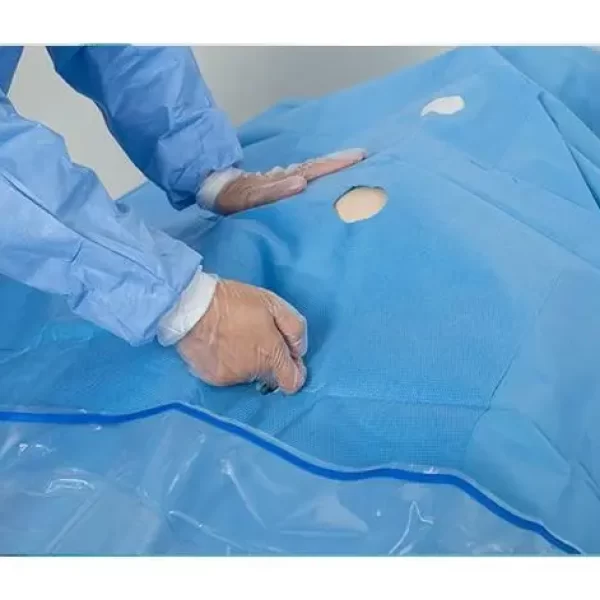Role of Surgical Drapes in Infection Control
Introduction
In the intricately woven tapestry of healthcare, every thread holds significance – and surgical drapes are one such indispensable thread. These unassuming components play an understated, yet vital, role in maintaining the sterility of the operating room and ensuring patient safety. By acting as a physical barrier, surgical drapes safeguard the surgical field from potential pathogens, thereby mitigating the risk of post-operative complications such as surgical site infections (SSIs). In this article, we delve into the crucial role that surgical drapes play in infection control and explore how their evolution is shaping patient outcomes.
Part I: Understanding the Purpose of Surgical Drapes
The surgical drape serves a fundamental purpose – to create a barrier between the surgical site and potential sources of contamination. This includes the patient’s own skin, clothing, and the surrounding operative environment. By delineating a sterile field, surgical drapes act as the first line of defense against microorganisms that could jeopardize the sterility of the surgical procedure.
Securing the sterile field is a meticulous task that demands unwavering attention and precision. Surgical drapes are designed to adhere securely to the patient’s body and the operating table, ensuring that the sterile field remains unbreached throughout the duration of the surgery. The role of the surgical drape, therefore, extends beyond merely covering the patient – it forms an integral part of the infection control strategy, contributing significantly to patient safety and the success of the surgical procedure.
Part II: Material Selection – A Critical Component in Infection Control
When it comes to infection control, the choice of material for surgical drapes is a determining factor. In the past, surgical drapes were made from woven materials such as cotton. However, woven fabrics, while breathable and comfortable, do not provide an absolute barrier against microorganisms, especially when they become damp or wet.
To overcome these limitations, modern surgical drapes are crafted from non-woven synthetic materials such as polypropylene or spunbond-meltblown-spunbond (SMS) fabric. These synthetic materials offer superior barrier properties against potential contaminants, including bacteria and viruses. They are also designed to be low-linting and resistant to tearing or puncturing, which further bolsters their infection control capabilities.
Part III: Innovation in Design – Raising the Bar for Infection Control
Over the years, the surgical drape has undergone significant design transformations to enhance its role in infection control. One such innovation is the inclusion of adhesive strips or incise films that adhere securely to the patient’s skin, creating a sealed interface around the surgical site. This adhesive barrier provides an additional layer of protection against microbial intrusions into the surgical field.
In addition to these adhesive features, modern surgical drapes may also incorporate integrated fluid collection pouches or channels. These features are designed to manage surgical fluids and minimize the risk of fluid contamination – a key factor in the prevention of SSIs. Some drapes also include transparent panels to enhance visibility of the surgical site or are treated with antimicrobial agents for added infection control.
Part IV: The Disposable vs. Reusable Drape Debate – Implications for Infection Control
The conversation around infection control also brings into focus the ongoing debate between disposable and reusable surgical drapes. Disposable drapes, which are intended for single-use, offer a compelling advantage in terms of infection control. By eliminating the risk of cross-contamination between patients and negating the need for sterilization, disposable drapes have been a game-changer for maintaining operating room sterility.
However, while disposable drapes offer considerable benefits in terms of infection control, they do pose significant environmental challenges, including waste generation and disposal issues.
Reusable drapes, on the other hand, require careful decontamination and sterilization between uses. While this process can be resource-intensive, reusable drapes can offer a more sustainable solution compared to their disposable counterparts. The caveat here is that the effectiveness of reusable drapes in infection control depends heavily on the thoroughness of the cleaning and sterilization process – any lapse can compromise the sterility of the drape and potentially the safety of the patient.
Part V: Looking Ahead – The Future of Surgical Drapes in Infection Control
As the surgical landscape continues to evolve, so do the demands on surgical drapes. Future innovations in surgical drape technology are poised to further elevate their role in infection control. One such prospect is the development of ‘smart’ drapes embedded with sensors that can monitor surgical site conditions or detect the presence of contaminants, providing real-time feedback to the surgical team.
Another exciting area of development is the incorporation of advanced antimicrobial agents into the fabric of the drape. This active defense strategy could offer an additional layer of protection against pathogenic threats, further reducing the risk of SSIs.
Parallel to these advancements, the drive for sustainability in healthcare is fostering innovation in the development of biodegradable surgical drapes. These eco-friendly alternatives could potentially reconcile the demand for high standards of infection control with the imperative to reduce the environmental impact of healthcare operations.
Conclusion
From their humble origins to the critical role they play in today’s surgical procedures, surgical drapes have come a long way. They stand as a testament to the medical industry’s commitment to patient safety and the unyielding pursuit of advancement in infection control. As the technology continues to evolve, surgical drapes will undoubtedly adapt and advance, promising safer and more successful surgical outcomes.
Please visit our website for more product details https://medposnonwoven.com/product/adhesive-side-surgical-drape/

